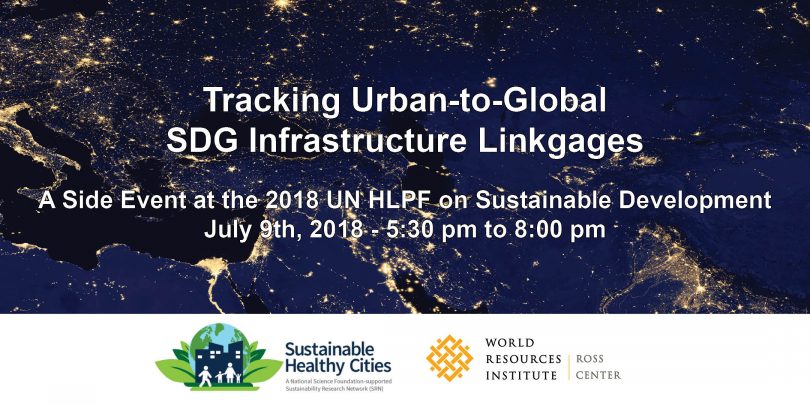Category Archives: Uncategorized
News
CONVENING: SHC Participates in International Workshops to Advance Science of Co-production
Sustainable Healthy Cities (SHC) Network research manager Sam Tabory recently participated in two workshops on the topic of co-production for knowledge and research advancement with practice and policy communities.
The first workshop explored co-production and co-creation for urban transitions and was hosted by the Dutch Research Institute for Transitions. The second workshop considered new directions in academic-practitioner engagement in public management and administration research and was hosted jointly by the University of Barcelona, the University of California Santa Barbra, and University College London.
Professor Anu Ramaswami of the University of Minnesota, who leads the SHC Network, was a co-author on both of the papers presented at these workshops which are expected to lead to special issue publications. Professor Richard Feiock of Florida State University, who co-directs the SHC Network, is a co-author on the paper exploring directions in academic-practitioner research collaborations.
Co-production, co-creation and academic-practitioner collaborations are emerging as particularly important topics among researchers seeking to generate actionable, relevant, and credible science on complex topics that intersect with policy and practice arenas. The SHC Network actively leverages co-produced science-to-action approaches in its interdisciplinary work on sustainable urban infrastructure transitions, but it also seeks to directly contribute to an emerging science of co-production unto itself.
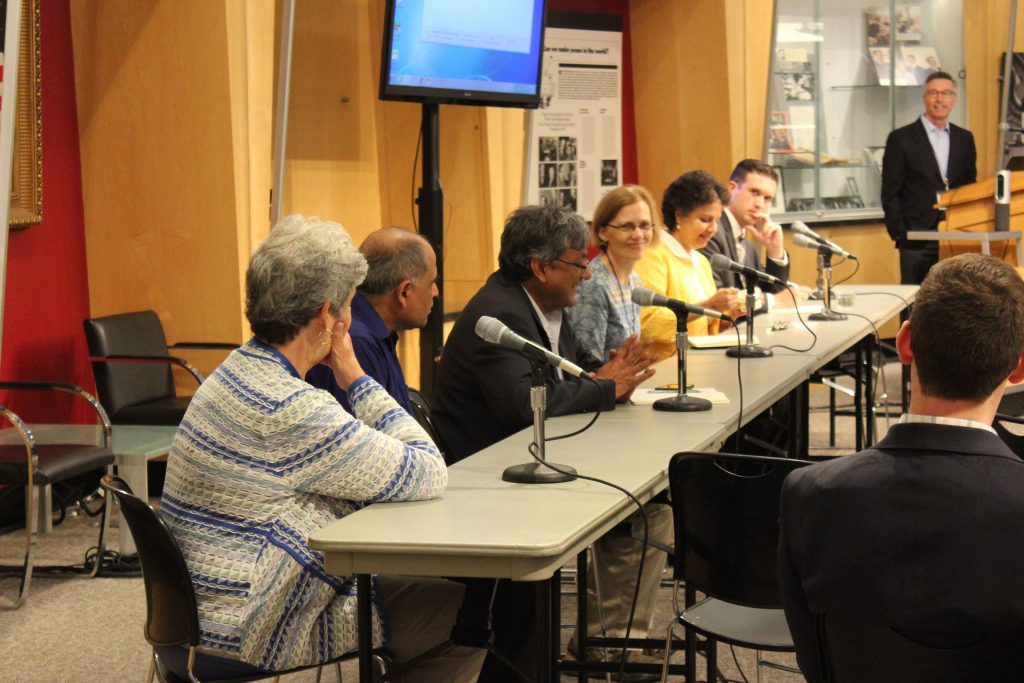
News
EDUCATION: Certificates Awarded in Sustainable Healthy Cities’ Education Program
The Sustainable Healthy Cities (SHC) Network would like to congratulate the students, postdocs and staff who earned its Graduate Education Certificate in Integrated Infrastructure Solutions for Sustainable, Healthy and Livable Cities.
The certificate program included the completion of three graduate level courses offered in an innovative hybrid format and taught by leading experts and practitioners from different disciplines. The courses were offered in two series beginning at SHC’s launch in August of 2015 through the spring semester of 2018. The classes included Interdisciplinary Environmental Study of Urban Sustainability; Defining and Measuring Environmental Sustainability, Health, Well-being, and Livability; and Distributed Infrastructure Solutions: Design and Policy.
We would like to thank all students and researchers for their time and contributions to Sustainable Healthy Cities’ research efforts. Congratulations on the completion of your Certificate. – SHC Executive Committee: Anu Ramaswami, Patricia Culligan; Armistead Russell; Richard Feiock
Graham Ambrose – University of Minnesota
Poorva Bedge – Colorado State University
Lara Clark – University of Minnesota
Kirti Das – University of Minnesota
Robert Elliott – Columbia University
David Farnham – Columbia University
Kyle Flanegin – University of Minnesota
Xavier Fonoll-Almansa – University of Michigan
Grace Garbini – University of Minnesota
Matt Grimley – University of Minnesota
Kate Gurke – University of Minnesota
Aaron Hanson – University of Minnesota
Priya Hora – University of Minnesota
Kelsey Kappler – University of Minnesota
Serena Kim – Florida State University
Raj Lal – Georgia Institute of Technology
Abi Lawal – Georgia Institute of Technology
Xinyu Liu – Ohio State University
Jonathan Lubin – Florida State University
Sudy Majd – Columbia University
Amy Motzny – Columbia University
Peter Nixon – University of Minnesota
Justine Oesterle – University of Minnesota
Neil Quarles – University of Texas Austin
Sukumar Santhanam – University of Minnesota
Joseph Servadio – University of Minnesota
Ruowen Shen – Florida State University
Shilva Shrestha – University of Michigan
Kate Wassel – Florida State University
Xinyi Wu – University of Minnesota
Shengxi Yuan – Columbia University
News
CONVENING: Science-Policy Dialogue on Metrics for Equity and Livability in Sustainable Cities
The Sustainable Healthy Cities (SHC) Network hosted a workshop October 16-17, 2018 with twenty-five city and policy partners to discuss concepts and metrics for livability and equity in sustainable cities. The workshop was titled “How Do We Define Equity and Livability for Sustainable Cities? A Joint Science-Policy Dialogue on Concepts and Metrics.”
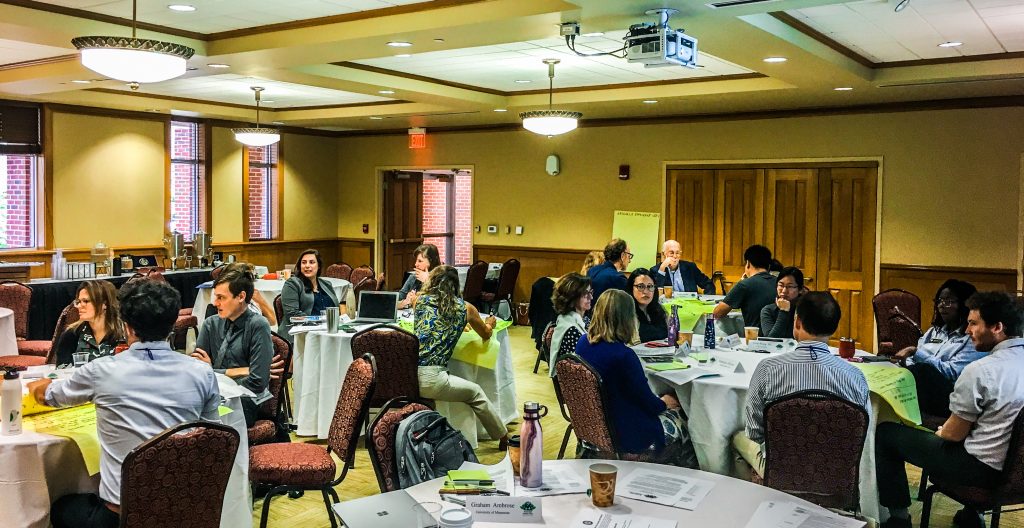
Highlights
Faculty from the Askew School of Public Administration and Policy at Florida State University and the Humphrey School of Public Affairs at the University of Minnesota jointly hosted the workshop in Tallahassee, FL. Representatives from city and policy organizations across the United States joined the dialogue alongside SHC researchers to consider key questions, including:
- How do we define and measure equity and livability in cities in the context of sustainable social and infrastructural systems?
- How do we understand equity and livability’s conceptual relationships with environment, health, and wellbeing?
- What is the science of these interactions? Are there new data sets and methods that can help cities track these outcomes?
Highlights from the two day event included working sessions to consider definitions for intermediate pathways and final outcomes relevant to considerations of livability and equity in cities, discussions of current trends in data collection and management for tracking equity outcomes including a consideration of the need for fine-scale data and potential citizen science contributions, and future planning for a potential equity-focused measurement pilot in select partner cities.
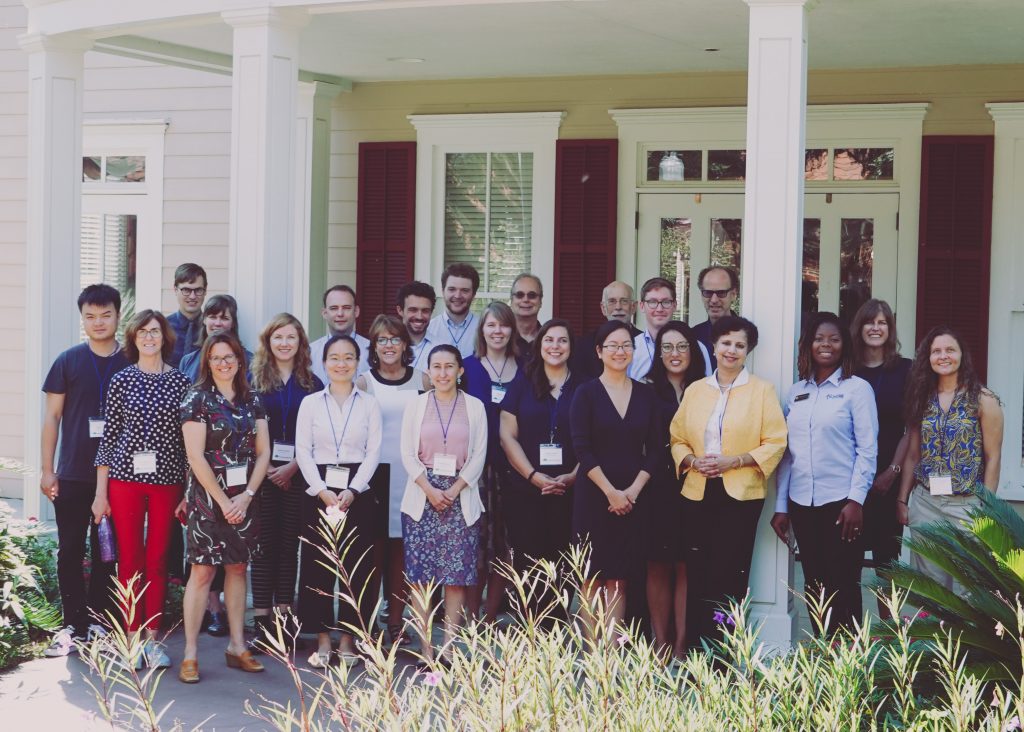
Participants
The conversations were informed by the diverse operational backgrounds of workshop participants spanning environmental protection, local food policy, public health, resilience planning, transportation and mobility services, electric utility operations, and more.
Represented organizations included the cities of Atlanta, Austin, Baltimore, Denver, Fort Collins, Minneapolis, New York City, St. Paul, Tallahassee, and Urbana. Additionally, Detroit Future City, Leon County (FL), HealthPartners, and the International City/County Management Association (ICMA) were also represented.
Support
The workshop was supported with funds from the U.S. National Science Foundation, award No. 1444745, project title “Integrated Urban Infrastructure Solutions for Environmentally Sustainable, Healthy, and Livable Cities.”
News
NEW STUDY: Can Local Food Production Meet Household Demand? A Look at 377 US Metros
Many US metro areas already have capacity today to be fully self-sufficient for key food items. What does this mean for urban agriculture and the eat-local movement?
A new study from the University of Minnesota, recently published in the journal Environmental Science & Technology, evaluated current local capacity of 377 US metro areas to meet household demand for four specific food items- milk/dairy, eggs, fruit and vegetables through local agriculture in and around urban areas. Uniquely, the study measured the capacity for local agriculture today to meet both direct demand for these items (i.e., eggs, eaten as scrambled eggs and tomato eaten directly in a salad), as well as the embodied or indirect agrifood demand (i.e., eggs present in bread or pasta, and tomatoes in pasta sauce). For example, while a typical US household may consume 159 lbs pf dairy per year, it would consume almost four times as much (615 lbs) in raw milk equivalents when we look at all the food we eat that includes butter, cheese, yogurt and milk in a variety of food items.
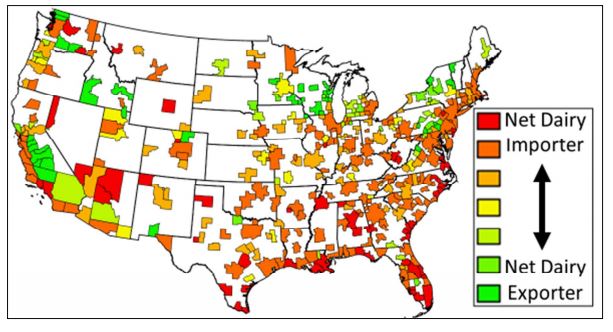
Even when considering the larger direct-plus-embodied demand for these agrifood items, the study found that about one in five (20%) of all US Metro Areas already has enough urban agriculture occurring within its boundary to be fully self-reliant in milk and egg requirements, evaluated on an annual basis. About one in ten (10%) of all US Metro areas already have capacity to fully provide their homes with their fruit and vegetable requirements across the diet. These self-reliant metro areas are areas of high agricultural production of these items. For other urban areas that need to import agrifood, the median local capacity is about 5% – meaning most of these urban areas can supply about 5% of the full diet demand for items such as eggs, vegetables, and fruits.
When agriculture up to a radius of 100 miles outside urban metro areas is also included, the study found that the proportion of self-sufficient metros increases significantly to 53%, 67%, 18%, and 41% being capable, today, of meeting the full direct plus-embodied needs of their households of dairy-equivalents, eggs, fruits, and vegetables, respectively.
Further, if one focuses on just the fresh/direct demand portion of these items that are minimally processed, i.e. fluid milk, fresh eggs, as well as unprocessed apples and tomatoes, the study finds that even greater numbers of metropolitan areas already have capacity for self-reliance, with 69% self-sufficient in their direct fluid milk consumption, 85% self-sufficient in their unprocessed egg consumption, and 34% and 81% self-sufficient in fresh apple and tomato demand respectively.
These data mean that there is already substantial agriculture already happening in and around several metro regions, sufficient to support at least a significant chunk if not all household demand for these specific agrifood items. This is a new and significant finding given that the public media highlight international cities’ capacity for self-reliance, such as Singapore and Shanghai.
“Our study shows the issue is not that we lack agricultural production for these select items in and around US metro areas, but that our present-day supply chains may not be connecting local production and local demand”, says Peter Nixon, a PhD student in bioproducts and biosystems engineering who worked on this study.
Indeed, the results suggest that we should think carefully about what specific purposes increasing local agriculture in and around cities will serve – is it to boost the local economy, or to serve under-served communities? Other benefits such as heat island mitigation, social cohesion and improved quality of life from engaging with food and nature in cities, can also play a big role.
“It is really important to assess these co-benefits and understand who will benefit from increasing urban agriculture in cities, and how,” says Professor Anu Ramaswami, co-author and advisor on this study, “Our dataset can help individual urban areas understand their own particular situation with respect to production-demand for food as a starting point for further food systems planning.”
News
POLICY ENGAGEMENT: Tracking Urban-to-Global SDG Infrastructure Linkages at UN High Level Political Forum
The Sustainable Healthy Cities Network, together with the WRI Ross Center for Sustainable Cities, will host a side event at the 2018 United Nations High Level Political Forum on Sustainable Development. The event is titled “Metrics for Tracking Urban-to-Global SDG Infrastructure Linkages: Science-to-Policy Listening Session on Knowledge Needs and Practice Constraints.”
The event will be held Monday July 9th from 5:30 to 8:00 pm at the United Nations Headquarters in New York City. If you are interested in attending, please register here.
Globally, infrastructure and food supply sectors—sectors that provide energy, water, food, buildings, transportation-communication, waste management services, and public spaces in human settlements—influence our ability to attain almost all of the SDGs. In the context of urban areas, these sectors shape a number of sustainability outcomes within urban boundaries, as indicated in the New Urban Agenda and SDG 11. While a perspective focused on cities’ geographic jurisdictions is helpful to a certain extent for individual cities wishing to advance human and environmental wellbeing, the larger implications of urbanization for planetary sustainability require a view that looks at cities as part of larger systems.
Understanding the full, systemic set of SDG linkages across infrastructure and food sectors from a cross-scale perspective can advance sustainability both locally within cities, as well as regionally and globally.
From a practice perspective, developing transboundary metrics that complement metrics purely focused within a city’s boundary, raises both opportunities and challenges. The objective of this event is to generate an open dialogue about technical best practices, as well as policy and practice opportunities and constraints, for tracking urban-to-global linkages between urban infrastructure/food system choices and SDGs that affect resource use, the economy, inequality, the environment, human health and wellbeing, and the climate.
This session will discuss locally as well as cross-scale relevant metrics for tracking urban sustainability actions focusing on four grounded topic areas that are emblematic of simultaneously local and transboundary challenges:
- Greenhouse gas emissions
- Air pollution
- Water stress
- Land expansion and consumption
The goal of the session is to better understand opportunities and constraints in mainstreaming transboundary SDG-infrastructure linkages and concepts as guides for practice, public investment, and policymaking.
For additional information, please contact srn.cities@gmail.com.
News
CONVENING: SHC Researchers Attend Prestigious 2018 Industrial Ecology Gordon Research Conference; Focus on Sustainable Development Goals
Sustainable Healthy Cities (SHC) researchers from the University of Minnesota and the University of Michigan attended the 2018 Gordon Research Conference (GRC) and Gordon Research Seminar for Industrial Ecology, held May 19th to the 25th, 2018 in Les Diablerets, Switzerland.
The convening’s theme this year was centered on “The Role of Industrial Ecology in Reaching the Sustainable Development Goals”. The GRC specializes in bringing together international research communities to discuss frontier research in the biological, chemical, physical and engineering sciences. The GRC Industrial Ecology community used this year’s convening to “investigate the newest insights on how Industrial Ecology can contribute to achieving the SDGs,” particularly focusing on “methods and approaches for assessing achievements and exploring synergies and tradeoffs between SDGs.”
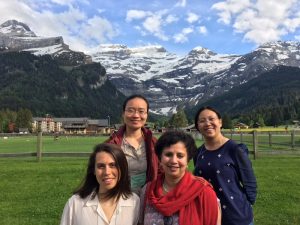
Two hundred attendees spent the week discussing topics organized within the themes of the 17 SDGs, and how the field of industrial ecology can aid in achieving these goals. SDG 11 directly addresses sustainable cities and communities, while many additional SDGs are directly shaped by actions and activities that are concentrated in urban areas, such as SDG 9 focused on industry and infrastructure, SDG 12 focused on responsible consumption and production, or SDG 13 focused on climate action.
Anu Ramaswami, SHC Network Director and professor of public affairs and bio-systems engineering at the University of Minnesota, served as this year’s conference co-chair. She will chair the next GRC Industrial Ecology Conference, which will be hosted in the United States in 2020. Stefanie Hellwig of ETH Zurich chaired this year’s conference.
Three SHC Network post-doctoral researchers from the University of Minnesota—Dana Boyer, Kangkang Tong, and Lin Zeng—as well as SHC Network faculty researcher Josh Newell of the University of Michigan, also participated in the conference and seminar.
Post-doctoral researcher Dana Boyer, presented work on, “Diversity of food flows, diets, supply chains and environmental impacts of nine Indian cities.”
Post-doctoral researcher Kangkang Tong presented work on, “Enabling Factors for Low-carbon Transitions of City-Wide District Energy Systems in the U.S.: Linkage with Multiple UN-SDGs.”
And post-doctoral researcher Lin Zeng presented work answering the question, “What is the land use footprint of urban and rural residents in the USA?”
The U.S. National Science Foundation was contributing sponsor to the 2018 Industrial Ecology GRC.
News
CONVENING: SHC Hosts Successful Internal Research Retreat and External Advisory Committee Meeting
May 9th through 11th , the Sustainable Healthy Cities Network (SHC) hosted a successful internal research planning retreat as well as an annual meeting of its external advisory committee.
More than 60 researchers from across the Network’s eight institutions spent two days in intensive planning sessions to align future research plans around both physical infrastructure modeling efforts as well as social actors and governance studies of diverse infrastructure transitions.
Following two days of internal research planning, the Network hosted its external advisory committee—comprised of academic, industry and policy representatives—for an evening research poster session and a subsequent daylong meeting to consider future strategic planning efforts for the network.
During the evening research poster session, the external advisory committee engaged directly with graduate and post-graduate researchers to learn about the latest research findings from across the network. Committee members, as well as Network faculty members, served as judges for the poster session, awarding top poster prizes in the following four categories:
Theme 1- Measurement of Infrastructure-Related Environment, Health, and Wellbeing Outcomes
- Title: Changes in Air Pollution Exposure Disparities by Race-Ethnicity and Socioeconomic Status: Outdoor Nitrogen Dioxide (NO2) in the United States, 2000-2010.
- Authors: Lara Clark, Dylan Millet, Julian Marshall
- Institutions: University of Washington, University of Minnesota
Physical Modeling Group 1- Energy, Transportation, and Waste Resource Recovery
- Title: Production of Platform Chemicals from Urban Organic Waste Streams Using a Novel Anaerobic Dynamic Membrane System
- Authors: Xavier Fonoll, Shilva Shrestha, Gislhain Djessi Tchouty, Brittany Colcord, Lutgarde Raskin
- Institutions: University of Michigan
Physical Modeling Group 2- Green Infrastructure, Urban Food Systems, and Stormwater
- Title: Diversity of food flows, diets, supply chains and environmental impacts of nine Indian cities
- Authors: Dana Boyer, Jatin Sarkar, Anu Ramaswami
- Institution: University of Minnesota
Social Actors and Governance- Individual Motivations and Behavior Change, Enterprise Strategy, and Institutional Configurations
- Title: Social Actors Motivations in Urban Food System: Consumer and Producer Perspectives
- Authors: Graham Ambrose, Rachel Kosse, Anu Ramaswami
- Institution: University of Minnesota
Following the evening poster session, the external advisory committee spent the next day discussing strategies around research alignment for high impact science advancement, external partner engagement, and science-to-policy research translation and communication efforts. The committee also met privately to prepare its annual evaluation of the Network, which will be submitted to the National Science Foundation for review.
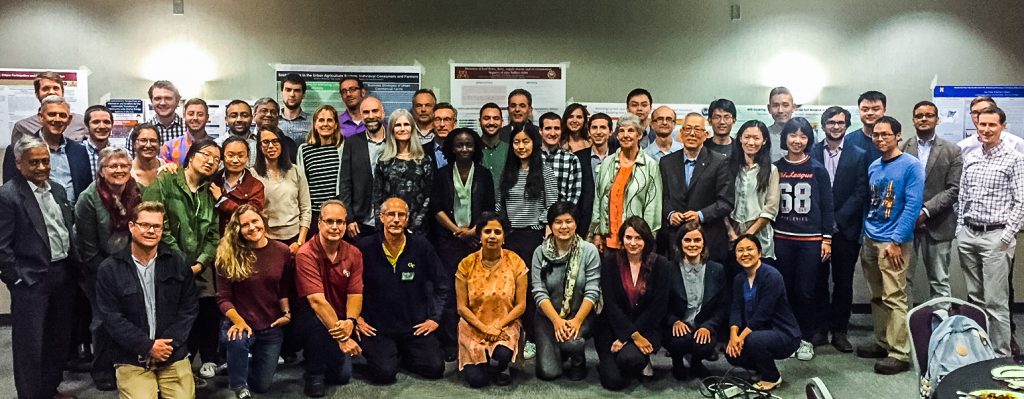
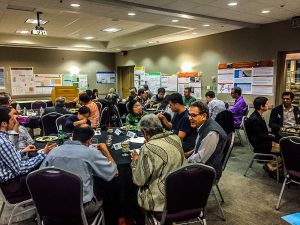
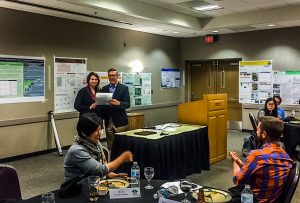
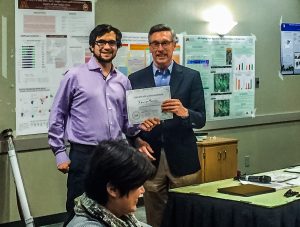
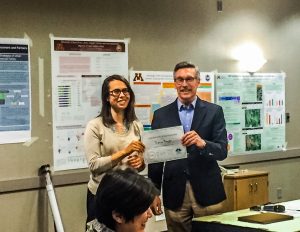
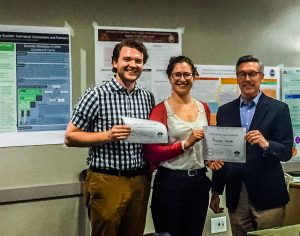
News
NEW STUDY: Material and Energy Requirements of Inclusive Development in 10 Indian Cities
What are the resource requirements of inclusive development in cities? Will providing infrastructure services to underserved urban residents dramatically increase community-wide resource demand? These questions are at the heart of new findings from Sustainable Healthy Cities researchers who quantified the material and energy flows needed to upgrade infrastructure and services for residents consuming below median values in 10 Indian cities.
Study results show that more equitable service provision for underserved households will not dramatically alter community-wide resource flows. Instead, it is the highest consuming households, as well as commercial businesses and industry, that have the largest impact on community-wide material and energy use. The full study was published in the journal Environmental Research Letters. Access the findings here.
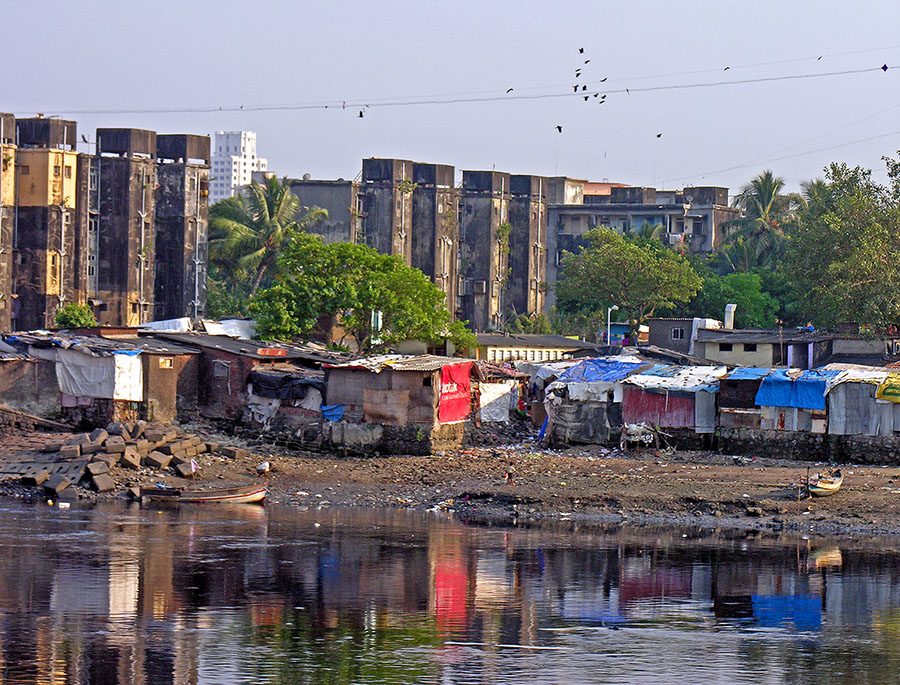
Among the UN Sustainable Development Goals (SDGs) are targets to reduce poverty and hunger, advance good health and wellbeing, provide clean water and sanitation, ensure access to clean energy, reduce inequality, and foster sustainable cities and communities. Individual SDGs that are specifically connected to goals of increasing access to infrastructure services and material development are often framed as being pitted against SDGs that have efficiency, conservation, and environmental sustainability as their aim. The thinking goes that rising levels of infrastructure service consumption among the world’s urban poor will put untenable strain on resources.
This study partially debunks that argument by showing that for the most part, inclusive development efforts in the 10 Indian cities studied would not substantially alter community-wide resource flows. The work required first quantifying service provision deficits (relative to median use levels or established benchmarks in various sectors) in each city and then comparing that quantified value to community-wide material and energy flows. The methodology was applied across the sectors of housing, electricity, and household cooking fuels.
Across all 10 cities, results show:
- To provide basic electricity (25 kWh capita-month) to all will require a 1% to 10% in current community-wide electricity use
- To provide basic clean liquid petroleum gas (LPG) fuel (1.2 kg capita-month) to all requires an increase of 5% to 40% in current community-wide LPG use
In Delhi and Chandigarh specifically, results show:
- Providing permanent shelter (implemented over a ten year period) to populations living in non-permanent housing would require a 6% to 14% increase over current annual community-wide cement use
- To provide permanent housing to all people living in structurally unsound housing andthose living in overcrowded housing (<5 m cap−2) would require 32%–115% of current community-wide cement flows
The study authors note that, “except for the last scenario, these results suggest that social policies that seek to provide basic infrastructure provisioning for all residents would not dramatically increase current community-wide resource flows.”
Moreover, the study’s findings show wealthier households consuming many times more than the lowest consuming households. As a result, the authors note, “the increase to community-wide resource flows that would be needed for socially inclusive development policies as a percentage of overall community-wide resource flow is much less than the percentage of homes that are underserved or that must be upgraded.”
The study offers a methodology than can be replicated in cities globally using location-specific data to understand service provision deficits and the material and energy flows needed to correct those deficits via inclusive development policies.
Lead author Anu Ramaswami is director of the Sustainable Healthy Cities Network and is the Charles M. Denny, Jr., Chair of Science, Technology, and Public Policy at the University of Minnesota’s Humphrey School of Public Affairs. Co-lead author Ajay Nagpure is an affiliated Sustainable Healthy Cities researcher and a post-doctoral fellow at the Humphrey School of Public Affairs. Co-author Mark Reiner is a research associate at the Humphrey School of Public Affairs.
News
COMMENTARY: Social Media Analysis for Urban Design, Management and Planning
Sustainable Healthy Cities researcher Richard Plunz, of the Urban Design Lab at Columbia University’s Earth Institute, is using social media analysis to understand how people use and engage with infrastructure and public space in cities. The tools his team is experimenting with represent a frontier for using social media analysis to inform urban design, management, and planning.
Twitter density analysis for understanding patterns and flows of people in public spaces, sentiment analysis for understanding connections between infrastructure and subjective wellbeing, and crowdsourced monitoring of storm water infrastructure during heavy rain events are just a few of the applied urban design, management and planning uses of social media that Plunz’s team is exploring.
Read the full story below. This post was originally published by Columbia News, written by Eve Glasberg. Access the original post here.
5 Questions: Richard Plunz on Crowdsourcing Urban Design with Twitter
During a storm, several thousand swales (low-lying channels that are shallower than a ditch) across New York City collect rainwater runoff and keep it from flooding the sewers. While working on an app to help monitor this system, Richard Plunz and his colleagues at the Earth Institute’s Urban Design Lab found that community involvement would be just as critical to its success as technology.
“The only practical way to monitor these sites is via social media, allowing people in the neighborhood to report on the status of green infrastructure,” said Plunz, director of the Urban Design Lab and a professor at the Graduate School of Architecture, Planning and Preservation.
Now, he and his colleagues are studying how this crowdsourcing approach might apply to the entire field of urban design. Their project combines mapping techniques with Twitter-usage data to gain a real-time understanding of how people occupy public space.
“Social media provides the first tool for gauging how areas with high-density tweets, such as parks, tourist attractions and transit hubs are actually used,” said Plunz, whose team collaborates on a broad range of multidisciplinary research projects, including investigations of new ecological realities facing cities, next-generation economic development and the intensifying effects of climate change. “Over time, we anticipate that social media will help us to produce a new generation of urban design and planning tools that address how to make these spaces more environmentally and socially resilient.”
Plunz, who is known for a wide range of innovative urban research, development and design projects, has a particular expertise in infrastructure. His landmark 1990 book, A History of Housing in New York City, was republished in a revised edition in 2016. In 2017 he published, City Riffs: Urbanism, Ecology, Place, which traces the changing perspectives of urban design by moving between 16 cities, including New York, Rome, New Delhi, Caracas and Seoul.
Q. What have you learned from analyzing Twitter use in public parks?
A. We have been able to confirm the efficacy of real-time geospatial tracking of information, which is already an important breakthrough in terms of urban design. What we did not anticipate was the potential for understanding sentiment regarding urban settings and in response to real-time tracking, and especially in affirming the accuracy of Twitter data relative to specific events and conditions. We have also considered the potential for predictions related to people and events. For example, in our work on the High Line, we can distinguish between New York residents and tourists. We can anticipate hours before an event that it could be oversubscribed and therefore require special precautions relative to security and logistics.
Q. What made you choose Bryant Park, Washington Square Park and the High Line?
A. These particular parks are representative of three differing ways that public space is used. Bryant Park has the most potential for Twitter-based analytics, given its heavy usage, especially on weekday lunchtimes. Washington Square Park has a much greater full-time occupancy, which gives a more expansive view of its use. The High Line’s long trajectory and large percentage of tourists provides yet another reading and perspective on the relationship between a park and its people. We are researching the effectiveness of Twitter in helping to understand these different characteristics in real time and the possibilities for correlating them with many variables, including weather patterns and social events.
Q. What can Twitter tell us that surveys can’t?
A. Twitter data is 24/7 and in continuum, a conscious stream, a collective picture of social responses to particular situations and contexts. It provides a tool for future planning as opposed to a system focused on specific issues at specific times. It is fundamentally cognitive in nature and, therefore, represents a huge advance in our comprehension of how we interact with our environment and vice versa.
Q. What are the practical applications?
A. There is real-time monitoring of public space density-of-use patterns and even usage prediction related to specific public events. It’s also possible to use Twitter density and sentiment as a tool for long-term design considerations. This can include, at different scales, the redesign of public parks—adding more grass and trees, for example, or new activity areas, or figuring out if nearby buildings or construction are having a negative impact on vegetation. Is a park being overused? Or are users dissatisfied and, if so, why? How can a park be more effective and have more social benefits? The next 10 years will be huge in reaching a new understanding of every aspect of our built environment via social media data.
Q. What are the limitations of this approach? Where would you like to see it go?
A. Perhaps the biggest limitation now is the uneven distribution of Twitter usage throughout the city. In our study we ended up focusing on lower Manhattan, in part because there is sufficient Twitter data for these areas. Central Park had to be eliminated because the Twitter-density patterns are so dispersed. We anticipate that this problem will disappear as the use of Twitter-like social media grows. That will be the moment when techniques like ours become everyday practice, opening a new window on to urban cognition. The cognitive mapping of urban environments entails a mental decoding of information. It has been a preoccupation for centuries, but more as a metaphysical construct. There have been iconic studies, from Italian architect Giambattista Nolli’s 1748 plan of Rome to Baudelaire’s 1847 Flâneur—who walks the city in order to experience it—to urban planner Kevin Lynch’s Image of the City analytics of the 1950s. We are moving from urban cognition as a primarily literary and conceptual tool into the realm of its becoming an operational tool for spatial design. This is a new moment for an ages-old preoccupation.
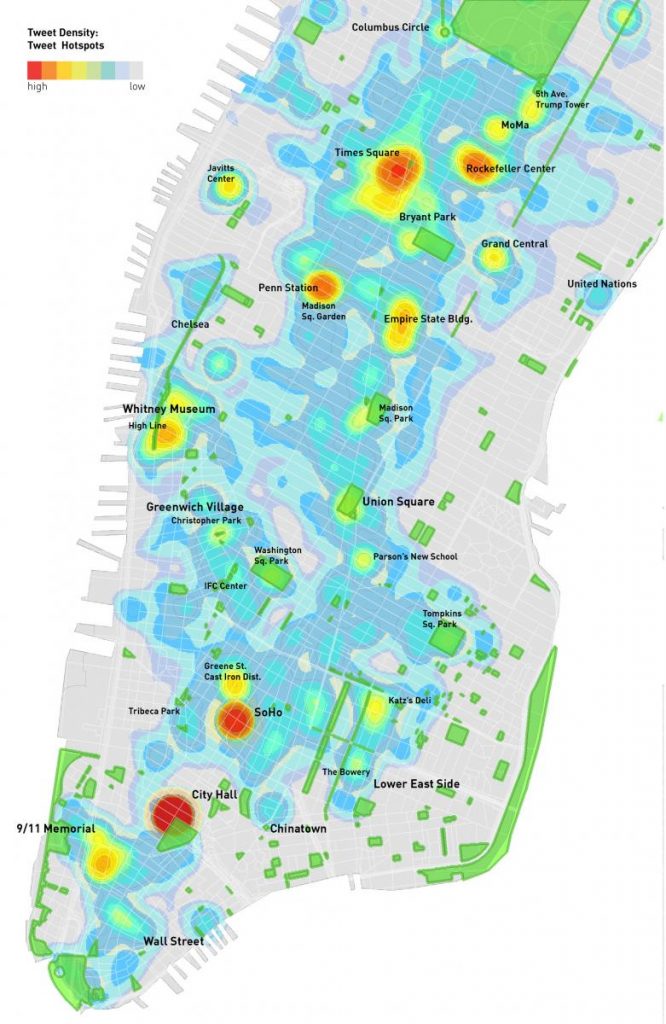
News
UPCOMING CONFERENCES: Cities, Sustainability, and Infrastructure Related Research Convenings
The following upcoming research conferences are convenings that may be of interest to the Sustainable Healthy Cities research community. The conferences are variously focused on topics of cities, sustainability, and infrastructure.
IPCC Cities and Climate Change Conference
The International Panel on Climate Change is hosting a conference on cities with the intent of inspiring the next frontier of research focused on the science of cities and climate change.
Themes of the conference include:
- Cities & climate change (Imperatives for action)
- Urban emissions, impacts and vulnerabilities (Science and practice of cities)
- Solutions for the transition to low carbon and climate resilient cities (Science and practice for cities)
- Enabling transformative climate action in cities (advancing science and advancing cities)
The conference will be held March 5-7, 2018 in Edmonton, Canada. Learn more about the conference here.
Gordon Research Conference: The Role of Industrial Ecology in Reaching the Sustainable Development Goals
The conference will focus on investigating the “newest insights on how Industrial Ecology can contribute towards achieving the SDGs” with a particular focus on “methods and approaches for assessing achievements and exploring synergies and tradeoffs between SDGs.”
The conference will be held May 20-25, 2018 at the Les Diablerets Conference Center in Switzerland. Learn more about the conference here.
2018 International Symposium on Sustainable Systems and Technology
In its 25th year, ISSST is one of the longest-running research conferences related to sustainability and the intersection of technology, policy, and behavior. The 2018 ISSST Conference will include a specific theme on circular economies.
The conference will be held June 26-28, 2018 in Buffalo, New York. Learn more about the conference here.
2018 APPAM International Conference: Public Policy for Sustainable Metropolitan Development
The Association for Public Policy Analysis and Management’s 2018 international conference will focus on concerns of sustainable urban development, paying special attention to how those concerns connect with the implementation of UN Habitat’s New Urban Agenda and the larger UN Sustainable Development Goals. The conference will highlight research that applies a metropolitan focus to concerns of sustainable urban development, particularly highlighting the challenges of multi-jurisdictional governance.
The conference will be held July 19-20, 2018 in Mexico City. Learn more about the conference here.
Urban Transitions 2018: Integrating Urban and Transport Planning, Environment and Health for Healthier Urban Living
Hosted by Elsevier conferences, Urban Transitions 2018 will consider the goal of promoting “healthy urban development”and provide enhanced understanding of linkages across health and urban development while providing insights to help guide multi-sector solutions. Supporting Elsevier publications include: Cities, Environment International, Environmental Pollution, Preventative Medicine, and Transportation Research.
The conference will be held November 25-27, 2018 in Barcelona, Spain. Learn more about the conference here.



